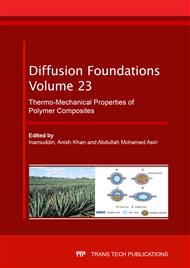[1]
A. Asada, K. Oguro, Y. Nishimura, M. Misuhata and H. Takenaka, Bending of polyelectrolyte membrane–platinum composites by electric stimuli, I. Response characteristics to various wave forms. Polymer Journal. 27 (1995) 436–440.
DOI: 10.1295/polymj.27.436
Google Scholar
[2]
E. Esmaeli, M. Ganjian, H. Rastegar, M. Kolahdouz, Z. Kolahdouz and G.Q. Zhang, Humidity sensor based on ionic polymer metal composites. Sensors and Actuators B: Chemical. 247 (2017) 498-504.
DOI: 10.1016/j.snb.2017.03.018
Google Scholar
[3]
W. Hong, A. Almomani and R. Montazami, Electrochemical and morphological studies of ionic polymer metal composites as stress sensors. Measurement. 95 (2017) 128-134.
DOI: 10.1016/j.measurement.2016.09.036
Google Scholar
[4]
S.J. Kim, S.M. Kim, K.J. Kim and Y.H. Kim, An electrode model for ionic polymer-metal composites. Smart Materials and Structures. 16 (2007) 2286-2295.
DOI: 10.1088/0964-1726/16/6/031
Google Scholar
[5]
L. Dai, Y. Zhang, H. Zhou, L. Li and H. Duan, Preparation of a New Ionic polymer-metal composite. Proceedings of the 2nd IEEE International Conference on Nano/Micro Engineered and Molecular Systems. (2007).
DOI: 10.1109/nems.2007.352102
Google Scholar
[6]
K.J. Kim, M. Shahinpoor, Ionic polymer-metal composites: II. Manufacturing techniques. Smart Materials and Structures. 12(1) (2003) 65.
DOI: 10.1088/0964-1726/12/1/308
Google Scholar
[7]
M. Yu, H. Shen and Z. Dai, Manufacture and Performance of Ionic Polymer-Metal Composites. Journal of Bionic Engineering. 4 (3) (2007) 143-149.
DOI: 10.1016/s1672-6529(07)60026-2
Google Scholar
[8]
J. Nam, T. Hwang, K.J. Kim and D.C. Lee, A new high-performance ionic polymer metal composite based on Nafion/polyimide blends. Smart Materials and Structures. 26 (3) (2017).
DOI: 10.1088/1361-665x/aa57cd
Google Scholar
[9]
Y. Jung, S.J. Kim, K. J. Kim and D.Y. Lee, Characteristics of ionic polymer-metal composite with chemically doped TiO2 particles. Smart Materials and Structures. 20 (2011) 13.
DOI: 10.1088/0964-1726/20/12/124004
Google Scholar
[10]
J.W. Paquette, K.J. Kim and D. Kim, Low temperature characteristics of ionic polymer-metal composite actuators. Sensors and Actuators A: Physical. 118 (1) (2005) 135-143.
DOI: 10.1016/s0924-4247(04)00541-2
Google Scholar
[11]
V. Panwar, C. Lee, S.Y. Ko, J.O. Park and S. Park, Dynamic mechanical, electrical and actuation properties of ionic polymer metal composites using PVDF/PVP/PSSA blend membranes. Materials Chemistry and Physics. 135 (2-3) (2012) 928-937.
DOI: 10.1016/j.matchemphys.2012.05.081
Google Scholar
[12]
I.S. Park, S.M. Kim, D. Kim and K.J. Kim, Mechanical properties of ionic polymer metal composites. Electroactive Polymer Actuators and Devices (EAPAD) 2007, edited by Yoseph Bar-Cohen, Proceedings of SPIE. 6524 (2007) 65241R.
DOI: 10.1117/12.716670
Google Scholar
[13]
D. Kim, K.J. Kim, J. Nam and V. Palmre, Electro-chemical operation of ionic polymer-metal composites. Sensors and Actuators B: Chemical. 155 (1) (2011) 106-113.
DOI: 10.1016/j.snb.2010.11.032
Google Scholar
[14]
S.N. Nasser, J.Y. Li, Electromechanical response of ionic polymer-metal composites. Journal of Applied Physics. 87 (2000) 3321.
DOI: 10.1063/1.372343
Google Scholar
[15]
M. Bennett, D. Leo, Morphological and electromechanical characterization of ionic liquid/Nafion polymer composites. In: Bar-Cohen Y (ed) Proceedings of SPIE 5759. Smart structures and Materials 2005: electroactive polymer actuators and devices (EAPAD). 5759 (2006).
DOI: 10.1117/12.599849
Google Scholar
[16]
I.S. Park and K.J. Kim, Multi-fields responsive ionic polymer-metal composites. Sensors and Actuators A: Physical. 135 (1) (2007) 220-228.
DOI: 10.1016/j.sna.2006.07.014
Google Scholar
[17]
Y. Cha and M. Porfiri, Mechanics and Electrochemistry of ionic polymer metal composites. Journal of the Mechanics and Physics of Solids. 71 (2014) 156-178.
DOI: 10.1016/j.jmps.2014.07.006
Google Scholar
[18]
S.N. Akhtar, J. Cherusseri, J. Ramkumar and K.K. Kar, Ionic Polymer metal Composites. Composite Materials, Springer Publications. (2016) 223-249.
DOI: 10.1007/978-3-662-49514-8_7
Google Scholar
[19]
A. Jo, D. Pugal, I.K. Oh, K.J. Kim and K. Asaka, Recent Advances in ionic polymer-metal composite actuators and their modelling and applications. Progress in Polymer Science. 38 (7) (2013) 1037-1066.
DOI: 10.1016/j.progpolymsci.2013.04.003
Google Scholar
[20]
M. Shahinpoor and K.J. Kim, Ionic polymer-metal composites: IV. Industrial and Medical Applications. Smart Materials and Structures. 14 (2005) 197-214.
DOI: 10.1088/0964-1726/14/1/020
Google Scholar
[21]
K. Krishen, Space applications for ionic polymer-metal composite sensors, actuators and artificial muscles. Acta Astronautica. 64 (11-12) (2009) 1160-1166.
DOI: 10.1016/j.actaastro.2009.01.008
Google Scholar
[22]
M. Shahinpoor, Y.B. Cohen, J.O. Simpson and J. Smith, Ionic Polymer Metal Composites (IPMCs) as Biomimetic Sensors, Actuators and Artificial Muscles-A Review. International Journal of Smart Materials and Structures. 7(6) (1998) 15-30.
DOI: 10.1088/0964-1726/7/6/001
Google Scholar
[23]
D.Y. Lee, I.S. Park, M.H. Lee, K.J. Kim and S. Heo, Ionic polymer-metal composite bending actuator loaded with multi-walled carbon nanotubes. Sensors and Actuators A: Physical. 133 (1) (2007) 117-127.
DOI: 10.1016/j.sna.2006.04.005
Google Scholar
[24]
B.K. Fang, M.S. Ju and C.C.K. Lin, A new approach to develop ionic polymer-metal composites (IPMC) actuator: Fabrication and control for active catheter systems. Sensors and Actuators A: Physical. 137 (2) (2007) 321-329.
DOI: 10.1016/j.sna.2007.03.024
Google Scholar
[25]
I. Dominik, J. Kwaśniewski and F. Kaszuba, Ionic polymer-metal composites displacement sensors. Sensors and Actuators B: Physical. 240 (2016) 10-16.
DOI: 10.1016/j.sna.2016.01.047
Google Scholar


